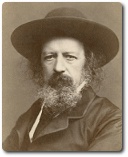Articles
- Poetry: Recognising poetic form
- Historical aspects
- Stylistic aspects
Victorian poetry
Public and private poets
Poet Laureate
 Alfred Tennyson became Poet Laureate in 1850 after the death of William Wordsworth. Both Laureates were household names, and their poems were quoted frequently. Tennyson's opinions on the affairs of the day were influential even at a political level, and in 1883 he was made Lord Tennyson by Queen Victoria, who certainly knew much of his poetry.
Alfred Tennyson became Poet Laureate in 1850 after the death of William Wordsworth. Both Laureates were household names, and their poems were quoted frequently. Tennyson's opinions on the affairs of the day were influential even at a political level, and in 1883 he was made Lord Tennyson by Queen Victoria, who certainly knew much of his poetry.
Private poets
Some poets, like Hopkins, Emily Bronte¸ or the American nineteenth century poet Emily Dickinson, wrote privately, and their poetry was not known during their lifetime, though it has become well-known since.
Even the famous Romantic poet John Keats was nearly as unfortunate. Although a small number of his poems had been printed, he was very little known till a few young men at Cambridge, including the future Poet Laureate, Tennyson, rediscovered him some 20 years after his death and made him famous.
Nineteenth century style
In the nineteenth century, the predominant influence was the poetry of the Romantics. Still popular in the middle of the century were Wordsworth, Shelley, Byron and Keats.
Emotion and vision
- Romantic poetry is poetry of the heart and the emotions, exploring the ‘truth of the imagination' rather than scientific truth.
- The ‘I' voice is central; it is the poet's perceptions and feelings that matter.
- Romantic poets often saw themselves as visionaries, seeing further and more deeply into the nature of the world or the supernatural than ordinary people did.
Nature
- The Romantic poets were particularly inspired by the realm of Nature. They were concerned that Nature should not just be seen scientifically but as a living force, either made by a Creator, or as divine in some way, to be neglected at humankind's peril.
- Some of them were no longer Christian in their beliefs. Shelley was an atheist, and, for a while, Wordsworth was a pantheist (someone who holds a sort of 'New Age' belief that God is in everything).
- Much of their poetry celebrated the beauty of nature, or protested the ugliness of the growing industrialization of the century, with its machines, factories, slum conditions, pollution and so on.
The past
Some of the Romantics, like Keats, also turned back to past times to find inspiration, either to the medieval period, or to Greek and Roman mythology.
Victorian re-interpretation
In the Victorian period, Tennyson and other poets were rather selective in what they wanted from the Romantics. They liked the emphasis on Nature, and on drawing on medieval and mythological material, but they were not so happy about the more visionary or philosophical aspects.
This made Victorian poetry easier for most people to understand, and so it retained its popularity. At the same time, general reading, especially the novel, was also becoming very popular as more and more people were becoming educated. Printing was becoming cheaper and cheaper, so the reading public was growing enormously.
The influence of Ruskin
Whilst Romanticism privileged Nature, it was often at a fairly general level. Ruskin wanted:
- An art that detailed Nature, just as the recently discovered photography could
- He expected artists to get out into Nature and see it as it really was
- In some ways he was building on what the great English painters John Constable and William Turner had done
- However, he wanted artists to go back and look at medieval art before the age of Raphael (1483-1520) and Michaelangelo (1425-1564)
- He believed that earlier artists had a perception of nature that had been destroyed by the later artists of the Italian Renaissance.
The Pre-Raphaelite Brotherhood
A number of young English artists took Ruskin seriously, and formed themselves into a group they called The Pre-Raphaelite (Brotherhood). Some of the best known names were Dante Gabriel Rossetti, Holman Hunt, John Millais and Edward Burne-Jones. Rossetti was also a poet, as was his sister Christina.
The Pre-Raphaelites wanted poetry and art to go hand in hand. They painted very representational and detailed pictures, often taking biblical or medieval subject matter, and they became immediately very popular.
Recently Viewed
-
Victorian poetry
now
Scan and go
Scan on your mobile for direct link.